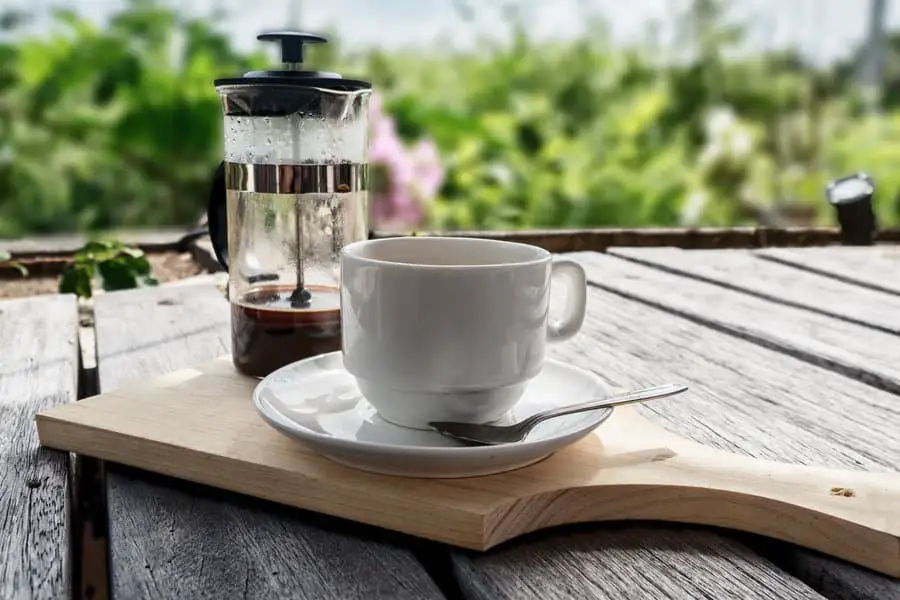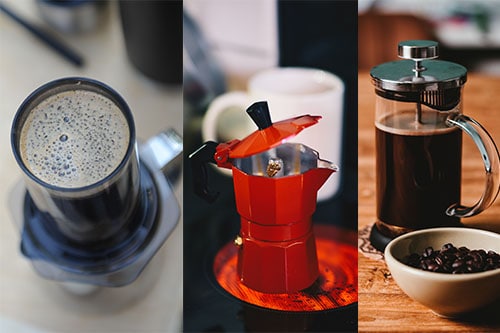
Espresso is a coffee lover’s dream—bold, rich, and packed with flavor. But if you don’t have an espresso machine, you3 Ways to Make Espresso Without an Espresso Machine
Espresso is a coffee lover’s dream—bold, rich, and packed with flavor. But if you don’t have an espresso machine, you might think it’s out of reach. Good news: you can still enjoy a solid cup of espresso at home or on the go without dropping hundreds on fancy equipment. Using simple tools like a French Press, AeroPress, or Moka Pot, you can brew espresso-style coffee that hits the spot.
This guide breaks down three tried-and-true methods to make espresso without a machine. Each method is affordable, beginner-friendly, and delivers a strong, concentrated coffee that’s close to the real deal. Plus, I’ve added a chart to help you pick the best option for you. Whether you’re at home, traveling, or just curious, here’s how to get your espresso fix.
Why Make Espresso Without a Machine?
Espresso machines are great, but they’re expensive, bulky, and not always practical. Maybe you’re renting a place without space for one, or you’re camping and craving a strong coffee. These methods use tools that are portable, budget-friendly (most cost under $50), and easy to master with a bit of practice. You’ll need fresh coffee beans, a grinder (or pre-ground coffee), hot water, and a little patience to get that bold, creamy espresso flavor.
1. French Press Espresso

The French Press is a classic coffee tool—simple, reliable, and perfect for brewing espresso-style coffee. It’s a glass or stainless steel container with a plunger and mesh filter that presses grounds to the bottom. You can pick one up from brands like Bodum for $20–$40, depending on size.
What You’ll Need
- French Press (8–12 oz for a single shot)
- Freshly roasted coffee beans
- Burr grinder (or medium-coarse pre-ground coffee)
- Hot water (195–205°F, about 30 seconds off boil)
- Kettle
- Spoon
- Scale (optional, for precise measurements)
Steps
- Grind Your Coffee: Use a burr grinder set to a medium-coarse grind, like coarse sand. Fine grinds clog the mesh filter, making your espresso gritty. Aim for 10 grams of coffee (about 2 tablespoons) for a 2 oz espresso shot, or a 10:1 water-to-coffee ratio (100 grams water to 10 grams coffee).
- Add Coffee to French Press: Place the grounds in the French Press. If using fresh beans, they’ll bloom and release a rich aroma when you add water.
- Pour Hot Water: Heat water to 195–205°F. Pour 100 grams (about 3.5 oz) over the grounds, covering them evenly. Stir gently to start extraction.
- Steep for 4 Minutes: Let the coffee steep. This mimics the slow extraction of espresso. Don’t rush it, or the flavor will be weak.
- Press Slowly: Press the plunger down gently over 20–30 seconds. A slow press ensures even extraction. Pour immediately into a small cup.
Tips
- Fresh beans make a big difference. If your coffee doesn’t bloom (bubble up), it’s likely stale, and the flavor will be flat.
- Avoid fine grinds to prevent sediment in your cup.
- Clean the French Press thoroughly to avoid old coffee oils affecting taste.
2. AeroPress Espresso
The AeroPress is a portable, modern take on the French Press, using a syringe-like design with paper or metal filters. It’s fast, versatile, and ideal for espresso-style coffee. You can grab one for $30–$50 online or at specialty coffee shops.
What You’ll Need
- AeroPress
- AeroPress paper or metal filters
- Freshly roasted coffee beans
- Burr grinder (or medium-fine pre-ground coffee)
- Hot water (195–205°F)
- Kettle
- Sturdy cup
- Scale (optional)
Steps
- Grind Your Coffee: Grind 14 grams of coffee (about 2.5 tablespoons) to a medium-fine consistency, like table salt. Too coarse, and the water flows through too fast, leaving a weak, sour shot.
- Prep the Filter: Place a paper or metal filter in the AeroPress cap. Rinse with hot water to remove paper taste and preheat the device. Attach the cap to the brewing chamber.
- Add Coffee: Put the grounds in the chamber and shake to level them. Place the AeroPress on a sturdy cup.
- Pour Hot Water: Add 50 grams (about 1.7 oz) of hot water (195–205°F). Stir for 10 seconds to ensure even extraction.
- Press: Insert the plunger and press down firmly over 20–30 seconds until you hear a hiss. The result should be a 1.5–2 oz shot. Dilute with a splash of hot water if you prefer a longer drink.
Tips
- Use a metal filter for a fuller body, similar to espresso.
- Experiment with grind size and press time to dial in the flavor.
- Check out AeroPress recipes online for variations, or browse Amazon for the latest AeroPress prices.
3. Moka Pot Espresso
The Moka Pot is a stovetop brewer that delivers a bold, intense coffee closest to true espresso. Invented by Bialetti, it uses steam pressure to force water through grounds, creating a rich, slightly creamy shot. Prices range from $25–$60, with Bialetti being a top choice.
What You’ll Need
- Moka Pot (1–3 cup size for espresso)
- Freshly roasted coffee beans
- Burr grinder (or medium pre-ground coffee)
- Hot water (or cold for traditional method)
- Stove
- Small towel (optional)
Steps
- Grind Your Coffee: Grind 10–12 grams (about 2 tablespoons) to a medium consistency, like fine sand. Too fine, and the coffee clogs; too coarse, and it’s under-extracted.
- Fill the Base with Water: Pour water into the bottom chamber up to the safety valve (not covering it). Using hot water speeds up brewing and reduces bitterness.
- Add Coffee to Basket: Fill the filter basket with grounds, leveling without tamping. Overpacking leads to bitter, over-extracted coffee.
- Assemble and Heat: Screw on the top chamber tightly but not excessively. Place the Moka Pot on medium heat. The water will boil, creating pressure to push coffee into the top chamber.
- Monitor and Remove: Listen for a gurgling sound, indicating the brew is nearly done. Remove from heat when the flow slows to avoid burning the coffee. Optionally, wrap the base in a cold towel to stop brewing instantly.
- Serve: Pour 1–2 oz into a small cup. Enjoy as is or dilute slightly for an Americano-style drink.
Tips
- Use medium heat to prevent scorching, which makes the coffee taste metallic.
- Clean the Moka Pot thoroughly after each use, avoiding soap to preserve the metal’s seasoning.
- Check Bialetti models on Amazon for consistent quality and current prices.
Which Method Should You Choose?
Each method has its strengths, depending on your budget, taste preferences, and setup. The French Press is the most affordable and forgiving for beginners but produces a slightly less concentrated shot. The AeroPress is portable and versatile, great for travelers or those who like to tweak their brew. The Moka Pot delivers the boldest, most espresso-like coffee but requires more attention to avoid bitterness.
Here’s a chart comparing the three methods:
Note: Scores are illustrative based on general user experience and not precise measurements.
Tips for Success
- Use Fresh Beans: Freshly roasted beans (within 2–4 weeks of roasting) give the best flavor. Grind just before brewing for maximum freshness.
- Get the Water Right: Water at 195–205°F extracts coffee properly. Too hot, and it burns; too cool, and it’s under-extracted. A temperature-controlled kettle helps.
- Practice Makes Perfect: Your first shot might not be perfect. Adjust grind size, coffee amount, or brew time to suit your taste.
- Clean Your Tools: Rinse French Press, AeroPress, or Moka Pot parts thoroughly to avoid stale coffee residue affecting future brews.
- Experiment: Try different beans or ratios to find your ideal espresso. Single-origin beans from Costa Rica or Ethiopia add unique flavors.
Final Thoughts
Making espresso without a machine is not only possible but also fun and rewarding. The French Press, AeroPress, and Moka Pot each offer a unique way to brew a strong, flavorful shot that rivals café quality. Whether you’re on a budget, traveling, or just love tinkering with coffee, these methods let you enjoy espresso anywhere. Grab some fresh beans, pick your tool, and start brewing. With a little practice, you’ll be sipping a bold, delicious espresso in no time.

